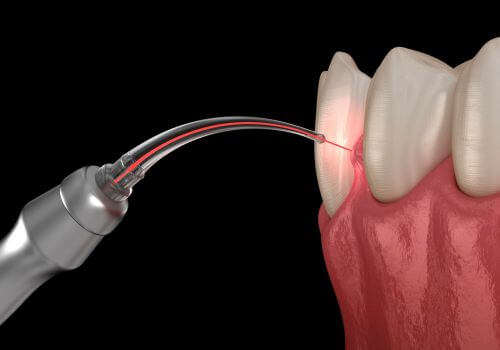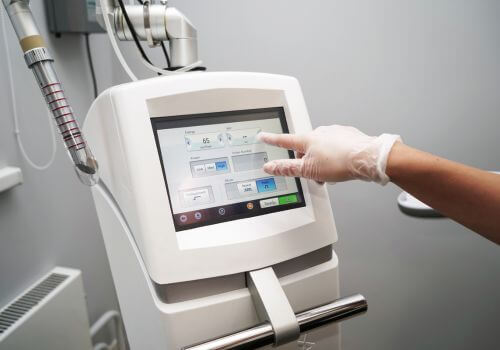Gum disease affects millions of Americans, often progressing silently until severe damage occurs. A laser-assisted new attachment procedure (LANAP) is a modern solution that treats moderate to advanced periodontitis with precision and minimal discomfort. This innovative approach has changed how we address gum disease by offering patients a less invasive alternative to traditional surgery.
What Is LANAP Treatment?
LANAP is an FDA-cleared laser procedure for treating moderate to severe gum disease. Unlike conventional gum surgery, which requires cutting and suturing, LANAP uses a specific wavelength laser designed to remove diseased tissue without damaging healthy gum tissue. The medical laser used for this procedure operates at a wavelength that targets infected tissue and harmful bacteria without damaging the surrounding cells.

The Science Behind LANAP’s Effectiveness
Treating gum disease with LANAP works on a simple but powerful principle. Laser energy eliminates the bacteria responsible for gum inflammation, removes diseased tissue with pinpoint accuracy, stimulates stem cells in your gums to form new connective tissue, and creates a stable fibrin clot that protects the treated area from food and bacteria.
As dental professionals, we find that LANAP creates ideal conditions for natural healing, allowing the body to regenerate bone and connective tissue damaged by periodontal disease. This biological response is what sets LANAP apart from conventional treatments.
What to Expect
Before beginning treatment, your dentist will measure pocket depths around each tooth using a specialized probe to establish a baseline for tracking improvement. Then, they will insert a thin laser fiber (about the thickness of a human hair) between the tooth and gum to remove bacteria and diseased tissue while leaving healthy tissue intact. The heat from the laser forms a fibrin clot that seals the pocket and connects the gum to the root, creating a protected environment for healing. The protected environment allows your body to regenerate lost bone and form new gum attachments to your teeth.
Benefits of LANAP Over Traditional Surgery
This revolutionary treatment offers several advantages, making it an excellent option for many patients.
The benefits of LANAP:
- Less discomfort with minimal pain during recovery
- Faster recovery, with most patients returning to normal activities within 48 hours or less
- No cutting or sutures
- Improved aesthetics
- Saves natural teeth that may otherwise need extraction
- Long-lasting results with good oral hygiene
Who Is a Good Candidate for LANAP?
LANAP works well for most patients with moderate to severe gum disease. It’s especially beneficial for people with dental anxiety who avoid traditional surgery, patients with health conditions like diabetes or heart disease, those taking medications that affect healing, smokers (though quitting improves results), and patients who have tried traditional treatments without success. Even people with advanced gum disease often qualify for LANAP, making it a good option for patients who might otherwise lose teeth.
Recovery and Aftercare
Most patients recover quickly after LANAP treatment. However, proper aftercare is essential for long-term success. Unless your dentist recommends otherwise, follow a soft food diet and avoid brushing or flossing the treated areas for the first two days after your procedure. Take prescribed medications as directed, and apply cold compresses if swelling occurs.
For the next week or two, brush gently with a soft-bristled toothbrush, resume careful flossing, avoid hard or sticky foods, and don’t use tobacco products. Long-term maintenance includes excellent oral hygiene, regular cleaning appointments, completing any recommended restorative work, and addressing habits that contribute to gum disease, like smoking.

Common Questions About LANAP
Does LANAP treatment hurt?
Patients usually report minimal discomfort during and after treatment. Using local anesthesia, your dental team will numb the area being treated before your procedure.
How many appointments will I need?
Typically, treatment requires two sessions of about 2-3 hours each, treating half your mouth per session. You’ll also need to attend a couple of follow-up visits to monitor your healing progress.
Will my insurance cover LANAP?
Insurance coverage for LANAP varies. Some plans cover the procedure when it is medically necessary, while others do not. Check with your insurance provider or contact your dentist’s office to determine your coverage and any potential out-of-pocket costs.
How long do the results last?
LANAP reattaches your gums to your teeth and can stimulate bone regeneration, creating lasting stability. With proper maintenance and good oral hygiene, you can expect the results to last for several years.
Making an Informed Decision
When considering treatment options for gum disease, ask the right questions.
Questions to ask your dentist about LANAP:
- Is LANAP appropriate for my specific condition?
- What results can I expect? How will we maintain my results long-term?
- What happens if I delay treatment?
- What is your experience with this procedure?
Signs of gum disease that indicate you should seek treatment:
- Bleeding gums during brushing or flossing
- Persistent bad breath despite good hygiene or teeth appearing longer
- Loose teeth or widening spaces between teeth
- Pus between teeth and gums
- Changes in how your teeth fit together when biting
Wrapping Up
Laser technology has revolutionized gum disease treatment. LANAP is an effective, comfortable alternative to traditional surgery that provides long-term results with minimal downtime. The procedure is well-tolerated by most patients, and the risk of complications is low.
If you’re tired of dealing with gum disease and ready to make a change, asking about LANAP could be the first step toward improving your oral health. Early intervention provides the best chance for successful treatment, so reach out to a dental professional at the first sign of trouble. Schedule a consultation with a LANAP-certified dentist today to learn if this innovative procedure might be right for you.
